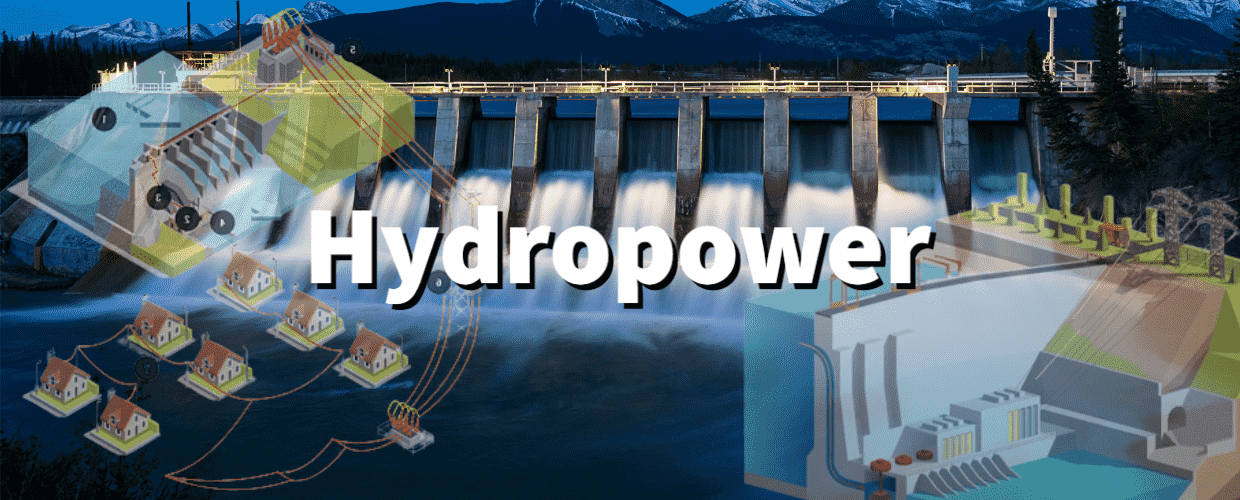Hydropower is one of the oldest and largest sustainable energy sources. It uses the natural flow of moving water to generate electricity. This article discusses hydropower, its importance, how it works, and its market value.
What is Hydropower?
Hydropower, often hydroelectric power, is a sustainable energy source that produces electricity by altering rivers or other bodies of water’s natural flow using a dam or other structure. The energy depends on the water cycle’s unending, constantly replenishing mechanism to generate energy using a fuel—water—that is neither diminished nor lost in the process. The turbines and generators transform this kinetic energy into electricity.
The history of water energy and hydroelectric power goes back thousands of years. The workings of the modern turbine began in the mid-1700s by a French pneumatic and military engineer.
“Hydropower is a clean and renewable energy source that provides affordable power throughout the country.” — Seth Moulton.
What are the Categories of Hydropower?
Hydropower can be divided into four basic categories:
Run-of-river
A run-of-river hydropower system captures the kinetic energy of flowing river water without the need for large reservoirs. Instead of storing water, it diverts part of the river’s flow into a canal or penstock, which directs the water through turbines to generate electricity. This method is considered environmentally friendly as it minimizes the impact on river ecosystems by maintaining natural water flow and levels. Run-of-river systems are particularly suited for regions with consistent river flow, offering a sustainable solution for electricity generation with reduced greenhouse gas emissions and lower ecological disruption compared to traditional dam-based hydropower.
Storage Hydropower
Hydropower systems that employ a dam to store water in a reservoir are known as “storage hydropower” systems. Electricity is generated by discharging water from the reservoir via a turbine, which powers a generator.
Pumped storage
Pumped storage hydropower generates peak-load electricity by circulating water between a lower and a higher reservoir when the system’s excess energy is available during periods of low demand.
Offshore Hydropower
Offshore hydropower is an emerging technology that harnesses the energy from ocean waves and tidal currents to generate electricity from saltwater. Unlike traditional systems, which rely on rivers or dams, offshore systems utilize marine environments’ vast and untapped potential. This innovative approach offers significant opportunities for sustainable energy production, particularly in coastal regions, by converting the ocean’s natural movements into a continuous and reliable power source. As technology advances, offshore hydropower is expected to play an increasingly important role in the global shift towards renewable energy.
How does Hydropower work?
Hydropower technologies generate power using the preference contrast, created by digression structure, of water flopping in on one side and out on the other. The energy source facilities come in various shapes and sizes, but the kinetic energy of flowing water always propels them as it travels downstream. The electricity from water power is subsequently used to power buildings, companies, and other establishments.
“Turbines designed for low-flow situations would be wasteful in times of high water. Turbines designed for high efficiency at, say, five hundred cubic feet per second might be ineffective in times of low water. Under certain conditions, turbines can go into a state of cavitation, wherein vaporizing water creates bubbles that implode on the metal and riddle it with tiny holes. The ideal turbine for a little mill up a creek somewhere in inconsistent country would be one that was prepared to take whatever might come, to sit there and react calmly in any situation, to respond evenly to wild and sudden demands, to make the best of difficult circumstances, to remain steadfast in time of adversity, to keep going, above all to press on, to persevere, and not vibrate, fibrillate, vacillate, cavitate, or panic – in short, to accept with versatile competence what is known in hydroelectrical engineering as the run of the river.” ― John McPhee, Silk Parachute.
Underground Surface and Powerhouse
A surface or subsurface power plant positioned far downstream to benefit from the river’s steep gradient between the dam and the tailrace. The main determinants of location choice are the project setting, site factors, and economic considerations.
In contrast to the more typical surface-based construction techniques, an underground power station is a form of hydroelectric power station built by excavating the principal components (such as the machine hall, penstocks, and tailrace) from rock.
Why is Hydropower important?
For thousands of years, hydropower has been recognized for its advantages. In addition to being a pure form of energy, power plants can directly provide power to the grid, serving as flexible and reliable backup power during major electricity outages.
Hydropower is not just about generating electricity. It offers a range of benefits, from flood control to supporting irrigation and providing a reliable water supply.
“In a typical year, Hoover Dam will generate about 4.5 billion kilowatt hours of energy,” said Mark Cook, Manager of the iconic Hoover Dam. “With the lake being the way it is now, it’s more like 3.5 billion kilowatt hours.”
How are growing global markets?
According to Precedence Research, The estimated global hydropower market size was USD 244 billion in 2022. It is expected to surpass USD 384.38 billion by the end of 2030, registering a compound annual growth rate (CAGR) of 4.7% from 2022 to 2032.
Major Market Players
Key market players leading the Hydroenargy industry may include Siemens Energy, General Electric (GE), Voith GmbH & Co. KGaA, TOSHIBA CORPORATION, FLOVEL Energy Private Limited, ANDRITZ, Natel Energy, Gilkes, Bharat Heavy Electricals Limited, SNC-Lavalin Group, Kolektor, Mavel, a.s., and Canyon Hydro.
Conclusion
Hydropower stands as a cornerstone of sustainable energy, having provided a reliable and renewable source of electricity for centuries. Harnessing the natural flow of water offers a clean alternative to fossil fuels, significantly reducing carbon emissions. The continued development and modernization of technologies are crucial for meeting global energy demands in an environmentally responsible manner. As the market for renewable energy grows, hydropower demonstrates the enduring value of this age-old energy source in our transition to a sustainable future.










